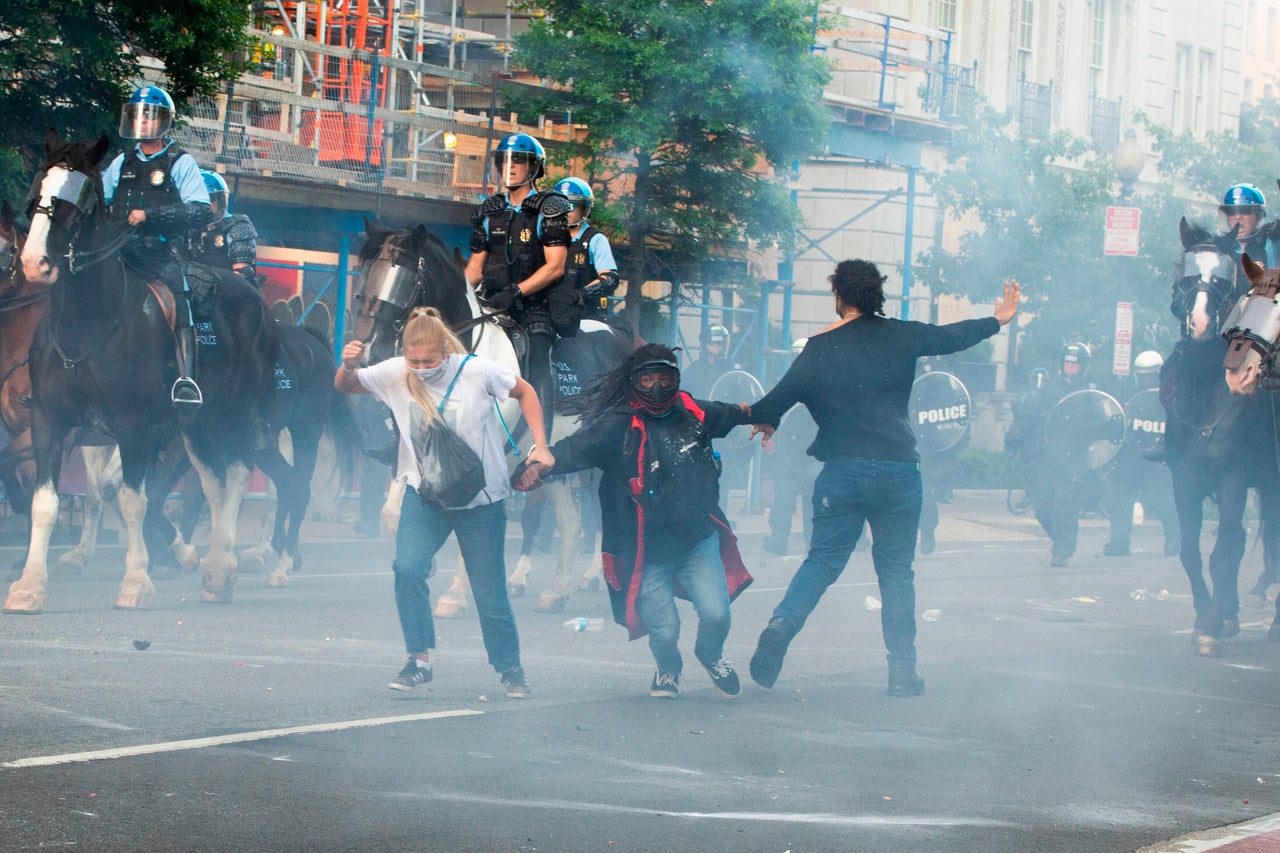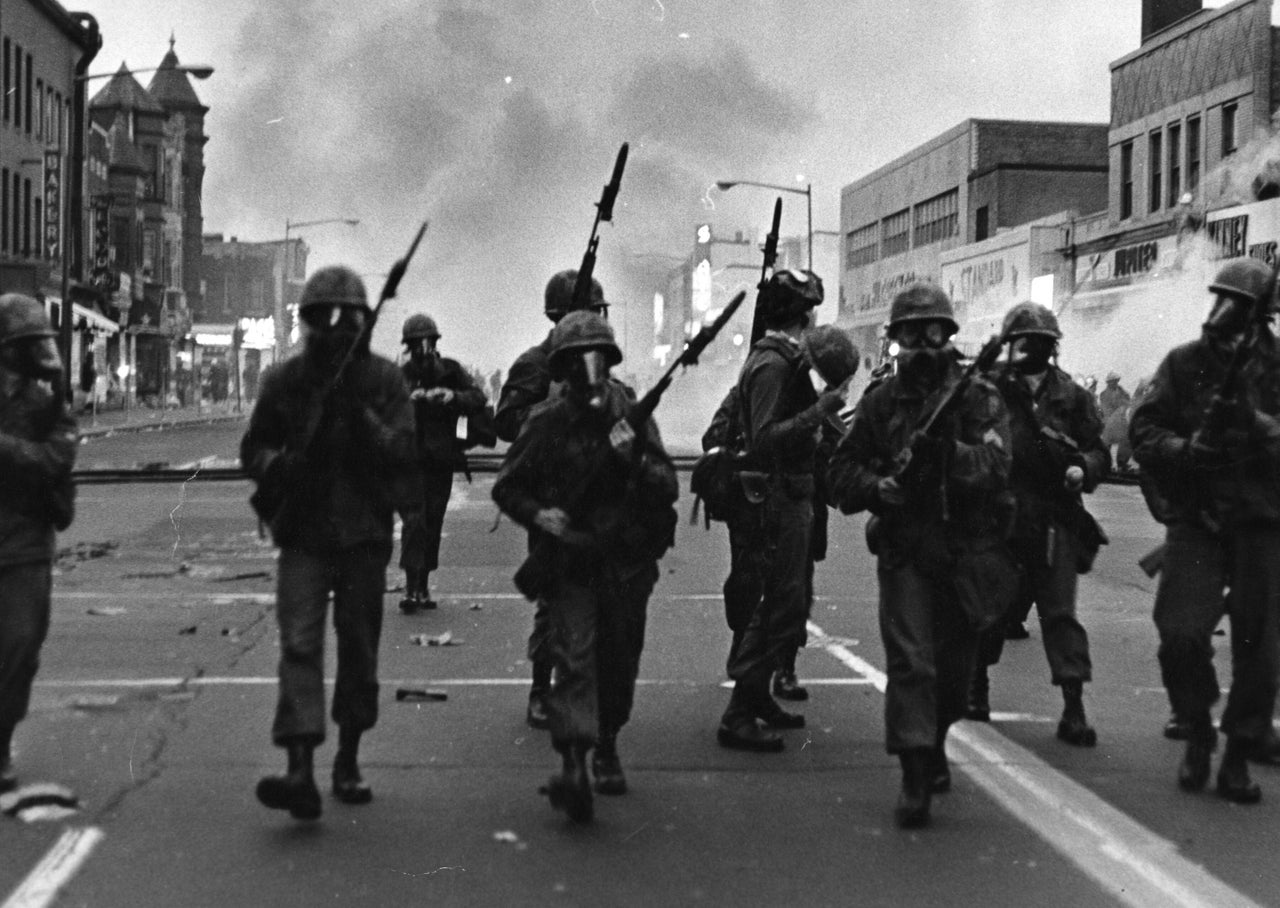In certain ways, 2020 feels a lot like 1968. Federal troops and local police are clashing with Black people sick of police brutality and discrimination. Americans are dying in massive, alarming numbers ― then, in the Vietnam war; now, as the coronavirus pandemic spreads across the nation. Americans are angry.
And President Donald Trump, in his bid for reelection, is echoing the same language Richard Nixon used in his successful 1968 presidential campaign.
“I am your president of law and order,” Trump said Monday on the South Lawn of the White House as the sound of peaceful protesters being violently dispersed with pepper pellets, smoke grenades, flash-bangs and baton-wielding military police echoed in the background.
He declared he would be the voice of the “Silent Majority” ― a favorite Nixon phrase parroted by Trump since he began his first presidential campaign in 2015. Now, it’s a nod to those who want the police to start cracking heads to quell widespread tumult, and Trump hopes to ride that wave of “law and order” backlash to reelection.
But for all of the similarities, 2020 isn’t 1968. The electorate has changed. Trump’s supporters are neither silent, nor a majority. And Trump ― who polling shows is an unpopular president ― isn’t in the same position in 2020 that Nixon was in 1968. Where Nixon ― seeking the White House ― offered himself as a solution to unrest and mismanagement, Trump ― the incumbent ― is its culprit.

When 1968 is summoned as a comparison to the present day, it is conjured as a symbol of chaotic change, upheaval, disorder and failure. Its milestones included the Tet Offensive in Vietnam that undermined any perception that the U.S. was prevailing in that war; the assassination of Martin Luther King Jr. and the ensuing riots in more than 40 cities that saw federal troops deployed to Chicago, Baltimore and Washington; the assassination of Robert Kennedy; a rising crime rate; the police riot at the Democratic National Convention ― all while the body count in Vietnam ticked up and up.
At the time, Nixon was running to replace President Lyndon Johnson, whom he argued had failed to enforce “law and order.” He knocked Johnson for his failures to quell riots, to subdue student activists and to win the war in Vietnam. Johnson, besieged from his left over his disastrous Vietnam policy, withdrew from the race.
When Vice President Hubert Humphrey took up the mantle, Nixon could not only blame him for the same failures as Johnson, but also for the continuing chaos after the Democratic Party’s contentious nomination of Humphrey inside the International Amphitheater in Chicago as the police rioted outside. Nixon’s focus on “law and order” and ending domestic turmoil worked because he could point to the people in the White House as the culprits.
The year 2020 seems similarly disorienting. A viral pandemic has caused depression-level unemployment and the botched government response has left more than 100,000 dead from the disease. Amid the pandemic, police and self-appointed vigilantes continued to kill Black Americans ― Ahmad Aubrey in Georgia, Breonna Taylor in Kentucky, and, in the tipping point, George Floyd in Minnesota. Police then violently repressed the protest movement sparked by Floyd’s killing as looters took advantage.
The president, meanwhile, has been woefully unable to rise to the challenges confronting him. In the early stages of the coronavirus threat, he called concerns raised about it a hoax. Finally responding to it, he teetered between endorsing stay-at-home measures to then endorsing protests to end them.
And that underscores a key difference between then and now ― Trump isn’t the challenger like Nixon, he occupies the office Johnson did in 1968. It is his challenger, former Vice President Joe Biden, who can make the case for the incumbent’s failures. Even as Trump tried to take no personal responsibility for any of his actions, it was his policies that led to a mismanaged pandemic response and his support for police brutality and repression that escalated the protests. Whatever failures of instituting “law and order” have occurred did so on his watch.
Nor can Trump’s situation be likened to Nixon’s 1972 reelection. The latter’s resounding win that year wasn’t the result of promises to restore “law and order,” but instead on his record as president and attacks on his rival as a left-wing extremist.
A Different Electorate
Today’s voting public is also very different than the one Nixon sought to win over in 1968.
Nixon’s “law and order” campaign worked because he was riding a wave of white backlash to civil rights activism and welfare policies that was gathering momentum. The backlash began after the passage of the Civil Rights Act of 1964 and Voting Rights Act of 1965 and the expansion of the welfare state under Johnson’s Great Society initiatives. These laws and programs became linked in the minds of many white Americans with riots in Black neighborhoods in Los Angeles’ Watts neighborhood, Detroit, Cleveland and elsewhere that exploded prior to 1968 after acts of police brutality or harassment. White voters began to oppose further civil rights legislation, in particular bills that would end unfair, racist housing practices.
In 1966, King protested for equal housing rights in Chicago’s Bungalow Belt. This was where descendants of Polish and German immigrants were able to buy into the American Dream of homeownership, but red-lining practices excluded Blacks. When King and his followers marched through the streets of this community, he was pelted with rocks and met with chants of “White Power!” and “Burn them like Jews!”
Voters in these once-solidly Democratic neighborhoods fueled the 1966 defeat of Democratic Sen. Paul Douglas, a committed civil rights advocate who King had once called the “greatest of all senators.” Nationally, public support for King collapsed, even before his 1967 “Beyond Vietnam” speech that earned him intense criticism, as Gallup measured his favorability as 32% positive and 63% negative.
Douglas wasn’t the lone liberal ― or policy ― to fall to the backlash against the civil rights movement during this period. New York City voters rejected a ballot initiative creating a civilian review board for police officers by a two-to-one margin. Anti-civil rights candidates won the governorships in Alabama, Florida and Georgia. California Gov. Pat Brown (D) lost his reelection to actor Ronald Reagan, the brash young standard-bearer of the new conservatism who expertly trolled student radicals and civil rights activists. “Whether we like it or not, the people want separation of the races,” Brown mused after his loss.
Contrast those results to the midterms of 2018. Trump, as he touted Republican candidates two years ago, renewed his rhetoric on race and crime with overhyped warnings of a caravan of dangerous undocumented immigrants poised to invade the country. While voters in solidly GOP states backed Trump in important Senate races, Republicans lost the House as the suburbs, which white voters had once fled to, turned sharply against the party and Trump.
In 1968, Nixon found a receptive audience as a champion for the white backlash. He warned of the “organizers of insurrection” in “Watts and Harlem and Detroit and Newark” and what they were “planning for the summer ahead.” The nation “must take the warnings to heart and prepare to meet force with force,” he said, adding, “our first commitment as a nation in this time of crisis and questioning must be a commitment to order.”

Half a century later, a significant increase in the public acknowledgment of racial discrimination has occurred, particularly among white Democrats. And amid the current ferment, support for civil rights protests is increasing, not decreasing.
A plurality of whites expressed backing for Black Lives Matter protests for the first time in May, according to a daily tracking poll by Civiqs conducted for the liberal blog Daily Kos. A HuffPost/YouGov poll found 78% percent of Americans, including 74% of white Americans, view police brutality as a serious problem.
Poll after poll also shows white Democrats increasingly agreeing with Black Americans that systemic racism is real and needs to be addressed. This convergence, dubbed the Great Awokening by Vox, is evident in the multi-racial nature of the protests in the streets around the country since Floyd’s death at the hands of the Minneapolis police.
“There is a change in mindset that’s taking place — a recognition that we can do better,” former President Barack Obama said at a roundtable discussion hosted by the Obama Foundation on Wednesday. Today’s protests are made up of “a far more representative cross-section of America ... that didn’t exist back in the 1960s,” he added.
What did exist in 1968 was a large group of voters opposed to the protests, the student radicals, the rock-and-roll culture and the demonstrations against the Vietnam War. Nixon’s law-and-order rhetoric was effective because it could peel away conservative white Democrats who already felt alienated from their party. But those voters are much fewer in numbers today, while moderate voters who typically vote Republican but are repelled by Trump’s rhetoric are up for grabs in this November’s elections.
One of Nixon’s most famous commercials was titled “Law and Order.” It featured fast-cut clips of burning buildings, young radicals, bloodied protesters and police in distress set to a discordant soundtrack. “I pledge to you we shall have order in the United States,” Nixon intoned.
Trump may pose for photo-ops for his personal social media audience today. But that is a strategy aimed solely at his closest followers. On Tuesday afternoon, less than 24 hours after Trump made his “president of law and order” declaration, his comments had been cut into a political ad. Tellingly, it is not Republicans who are using Trump’s words, but Democrats. Priorities USA, a Democratic super PAC, plans to air the spot in this campaign’s most crucial states: Michigan, Wisconsin and Pennsylvania.
The ad highlights the violent dispersal of peaceful protesters from in front of the White House so Trump could stroll out for his photo-op in front of the historic St. John’s Episcopal Church. It ends with the voice of Bishop Mariann Edgar Budde of the Episcopal Diocese of Washington from a CNN interview.
“The president just used a Bible and one of the churches of my diocese as a message antithetical to the teaching Jesus,” Budde says. “I just can’t believe what my eyes are seeing.”
The message is clear: Americans may still worry about law and order, but they should see Trump as a threat to it, not the solution.
